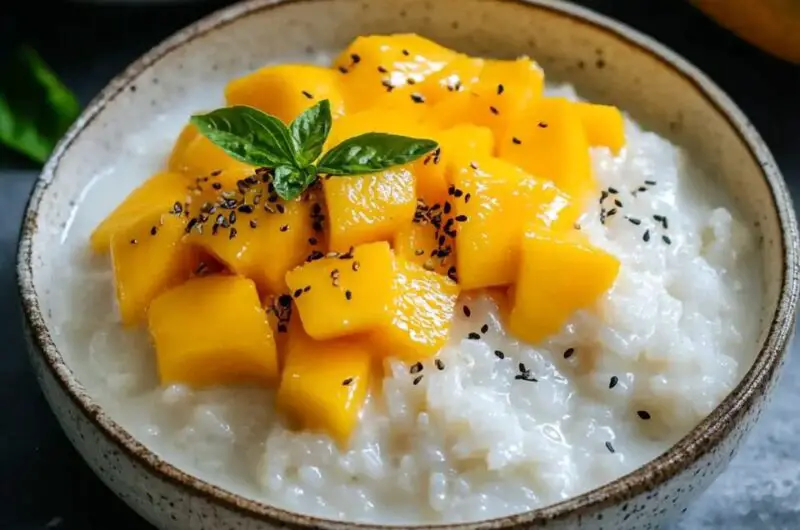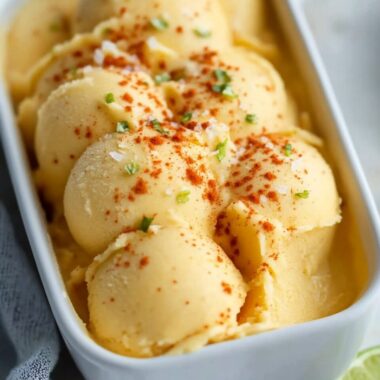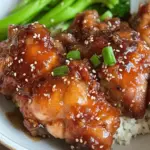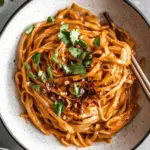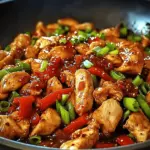The Cultural Legacy of Mango Sticky Rice
This dish has deep roots in Thai cuisine and is a seasonal staple during the hot summer months when mangoes are at their peak. It’s often enjoyed during the Thai New Year (Songkran) or as a popular street food dessert served fresh at night markets. In Thailand and across much of Southeast Asia, mango sticky rice is more than just a dessert—it’s a celebration of the region’s agriculture, particularly its prized fruits and rice varieties.
Sticky rice, also called glutinous rice, is a staple in many Asian households and is especially common in northern and northeastern Thailand. Its unique texture—soft, elastic, and slightly sticky—makes it ideal for soaking up the sweet, coconut-infused sauce that defines this dish.
Why This Recipe is a Modern Favorite
This homemade mango sticky rice recipe stays true to its origins while offering a healthier, customizable alternative to restaurant versions. By controlling the amount of sugar and choosing quality ingredients, you can enjoy a dessert that’s lighter, fresher, and free of additives or excess sweetness.
Unlike many overly rich desserts, mango sticky rice feels indulgent without being heavy. The creamy coconut milk offers just enough richness, the mango brings a natural fruity sweetness, and the rice provides a satisfyingly chewy foundation. Each bite delivers a harmonious blend of textures and flavors that soothe and delight.
Flavor Profile and Texture
The magic of mango sticky rice lies in its layers of taste and mouthfeel. The sticky rice, when properly steamed and mixed with coconut milk, becomes moist, tender, and slightly sweet. Coconut milk lends a creamy richness with subtle nutty notes, while the sugar enhances but doesn’t overpower the other ingredients.
Fresh mango slices introduce a juicy brightness that complements the creamy rice. When paired together, the soft rice and crisp mango create a satisfying contrast that makes this dessert unforgettable. Optional garnishes like toasted sesame seeds or mung beans add a bit of crunch and earthiness, enhancing the sensory experience.
Healthier and Naturally Allergen-Free
Mango Sticky Rice is inherently gluten-free and vegan, making it a great option for a wide variety of dietary needs. By using coconut milk instead of dairy and omitting animal-based ingredients entirely, this dish offers a naturally plant-based dessert that doesn’t compromise on flavor.
Coconut milk provides healthy fats, particularly medium-chain triglycerides (MCTs), which may support metabolism and energy. Mangoes are rich in Vitamin C, fiber, and antioxidants, while sticky rice, though high in carbs, is easy to digest and serves as an excellent energy source.
You can also reduce the sugar content or replace it with natural sweeteners like maple syrup or coconut sugar for a more wholesome version without losing the tropical essence of the dish.
Making Mango Sticky Rice at Home
The recipe’s beauty lies in its simplicity. With just a handful of ingredients and a little time, you can recreate this iconic dessert in your own kitchen. The key to perfect sticky rice is proper soaking and steaming. Unlike boiling, steaming preserves the grains’ shape and texture, resulting in a pleasantly chewy consistency that absorbs the coconut sauce without becoming mushy.
The coconut sauce is gently simmered to dissolve the sugar and infuse the milk with flavor. If your sauce is too thin, a small amount of cornstarch helps thicken it into a silky glaze that clings beautifully to the rice and mango. This attention to texture transforms a simple dish into something restaurant-worthy.
Tips for the Best Mango Sticky Rice
-
Choose ripe mangoes: The flavor and sweetness of your mangoes will make or break the dish. Look for golden-yellow, slightly soft mangoes with a strong fruity aroma.
-
Use glutinous rice only: Substituting with regular rice won’t achieve the sticky, chewy consistency required. Glutinous rice can be found in Asian grocery stores or online.
-
Don’t skip the soak: Soaking the rice overnight shortens steaming time and ensures even cooking.
-
Use full-fat coconut milk: This ensures the sauce is rich and creamy. Shake the can well to combine the coconut cream and liquid before using.
-
Adjust the sauce to your liking: Add more or less sugar to match your preferred sweetness level. If you like a thicker sauce, use the cornstarch mixture as needed.
Serving Suggestions and Presentation
To serve, spoon a generous portion of warm sticky rice onto a plate or banana leaf. Arrange mango slices on the side and drizzle with extra coconut sauce. A sprinkle of toasted sesame seeds, mung beans, or even shredded coconut adds texture and elegance.
For a festive presentation, serve in small bowls or shape the rice into domes using a ramekin or mold. Add a wedge of lime or a mint leaf for a pop of color and brightness.
Mango Sticky Rice also makes a delightful finish to Thai-inspired meals, pairing well with dishes like green curry, pad Thai, or spicy papaya salad. Its cooling, sweet nature balances out savory and spicy flavors beautifully.
Creative Variations
While the classic version is always a favorite, you can experiment with additions and substitutions to keep things exciting:
-
Infuse the coconut milk with pandan leaves for a subtle floral note.
-
Swap the mango with other fruits like ripe peaches, strawberries, or lychee for a seasonal twist.
-
Try black sticky rice for a dramatic color contrast and nuttier flavor.
-
Serve chilled for a refreshing summer dessert or warmed for cozy comfort food.
Why You’ll Love This Dessert
Mango Sticky Rice offers everything you could want in a dessert—sweetness, creaminess, freshness, and texture. It feels like a decadent treat, but it’s made with natural, minimally processed ingredients. It’s easy to prepare, visually beautiful, and universally loved, making it a go-to for family meals, special occasions, or when you simply crave something tropical and soul-satisfying.
It’s also a wonderful introduction to Thai desserts for those unfamiliar with Southeast Asian cuisine. Whether you’re serving it at a dinner party or enjoying a quiet night in, Mango Sticky Rice has a way of making every bite feel like a warm hug from a sunny place.
Conclusion
Mango Sticky Rice is a shining example of how a few simple ingredients—rice, coconut, and fruit—can be transformed into something truly special. This beloved Thai dessert combines comfort, elegance, and tropical flavor in every bite. Naturally gluten-free and vegan, it’s inclusive, adaptable, and easy to make at home. Whether you’re exploring Thai cuisine for the first time or revisiting a nostalgic favorite, this dish delivers an unforgettable experience that’s as pleasing to the palate as it is to the soul. A timeless dessert that celebrates mango season, tradition, and the joy of homemade goodness.

